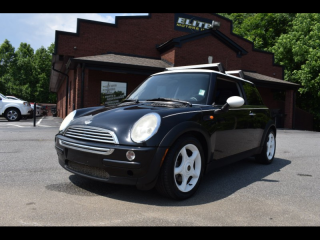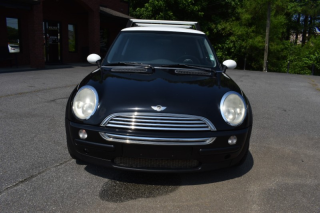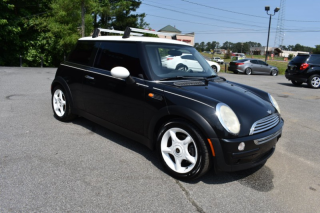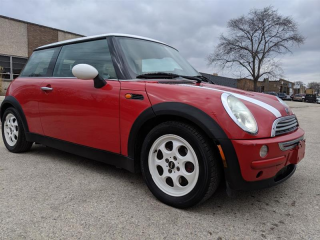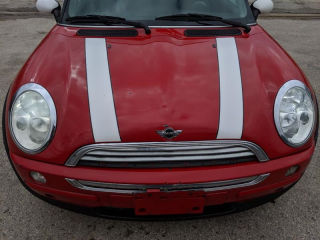The Good
Its key advantages include legendary nimble handling and spirited performance, especially in the supercharged Cooper S, appealing strongly to emotional buyers seeking driving fun. Practical buyers appreciate its distinctive, space-efficient design, relatively good fuel efficiency, and compact size ideal for city driving. It offers surprising comfort for its class and remains a strong value on the used market for its unique character.
The Bad
Known weaknesses include the power steering pump being prone to failure, issues with the Continuously Variable Transmission (CVT) in base Cooper models, and front control arm bushings wearing out. Electrical gremlins, oil leaks, and potential supercharger service needs on the 'S' model are also common concerns, demanding diligent maintenance attention.
2003 Mini Cooper: Quick Overview
- Engine Options:
- Mini Cooper (R50): 1.6-liter "Tritec" naturally aspirated inline-4 engine.
- Mini Cooper S (R53): 1.6-liter "Tritec" supercharged inline-4 engine with an intercooler.
- Horsepower:
- Mini Cooper: 115 hp @ 6,000 rpm.
- Mini Cooper S: 163 hp @ 6,000 rpm.
- Fuel Economy (EPA estimates for manual transmission):
- Mini Cooper: Approximately 25 MPG city / 33 MPG highway (combined 28 MPG).
- Mini Cooper S: Approximately 23 MPG city / 30 MPG highway (combined 26 MPG). Note: Cooper S requires premium fuel.
- 0-60 MPH Times:
- Mini Cooper: Approximately 8.5 - 9.2 seconds (manual).
- Mini Cooper S: Approximately 6.6 - 7.0 seconds (manual).
- Towing Capacity:
- The 2003 Mini Cooper is generally not rated for towing in the U.S. and towing is not recommended by the manufacturer.
- Trim-Level Features:
- Mini Cooper (R50): This base model typically came with a 5-speed manual transmission as standard, with an optional Continuously Variable Transmission (CVT). Standard features included power windows and locks, air conditioning, a CD player, six airbags, anti-lock brakes (ABS), and 15-inch steel wheels. Optional packages offered alloy wheels, a panoramic sunroof, sport seats, and chrome exterior trim.
- Mini Cooper S (R53): The performance-oriented 'S' model featured the supercharged engine paired exclusively with a 6-speed manual transmission. It added a sport-tuned suspension, distinct styling cues like a functional hood scoop and twin center-exit exhaust, and 16-inch alloy wheels. Interior upgrades included sport seats, more aggressive gauges, and often more robust upholstery options. Available options included a limited-slip differential, Dynamic Stability Control (DSC), Xenon headlights, heated front seats, a Harman Kardon premium sound system, and the Chrono Package which added auxiliary gauges (oil temperature, oil pressure, water temperature, battery voltage) mounted on the steering column. The Cooper S offered a more engaging and aggressive driving experience compared to the standard Cooper.
2003 Mini Cooper Specifications
Vehicle Information
| Year | 2003 |
| Make | Mini |
| Model | Cooper |
| Trim | - |
| Style | - |
| Type | Hatchback |
| Category | Compact Car |
Manufacturing Details
| Made In | Germany |
| Manufacturing City | SPARTANBURG |
Dimensions
| Doors | 2-Door |
| Curb Weight | - |
| Gross Vehicle Weight Rating | 4000 pounds |
| Overall Height | - |
| Overall Length | - |
| Overall Width | - |
| Wheelbase Length | - |
| Standard Seating | - |
Engine & Performance
| Engine | 1.6L L4 |
| Engine Size | 1.6L |
| Engine Cylinders | 4 |
| Transmission | 5-Speed Manual |
| Transmission Type | Manual |
| Transmission Speeds | 5-Speed |
| Drivetrain | Front-Wheel Drive |
Additional Features
| Anti-Brake System | - |
| Steering Type | - |
Pricing
| Manufacturer Suggested Retail Price (MSRP) | - |
| Invoice Price | - |
| Delivery Charges | - |
Vehicle History Report
Specifications
History
Events
History Check
Check
Check
Check
Check
Listings
Recalls
Check
Analysis
What Problems Does the 2003 Mini Cooper Have?
For the base Cooper (R50) equipped with the Continuously Variable Transmission (CVT), this transmission is a significant weak point. Early CVT units were prone to premature failure, manifesting as slipping, shuddering, or complete loss of drive, often requiring expensive replacement or rebuilding. Manual transmission versions of both the Cooper and Cooper S are generally more reliable in this regard.
Suspension components, particularly the front control arm bushings, are known to wear out, leading to clunking noises and vague steering. Engine mounts can also degrade over time, causing increased vibration. On the supercharged Cooper S (R53), specific attention should be paid to the supercharger service interval; the supercharger's oil should ideally be changed around 100,000 miles, as neglecting this can lead to internal damage. The bypass valve on the Cooper S can also fail, affecting boost delivery.
Other common issues include various oil leaks (e.g., oil pan gasket, crank position sensor o-ring), coolant leaks from the expansion tank, and electrical problems such as failing window regulators, central locking issues, or dashboard warning lights. Interior trim pieces can become brittle or show wear. While not catastrophic, these issues can accumulate and make ownership more expensive than anticipated if not addressed proactively. Long-term reliability is dependent on consistent, thorough maintenance and addressing these known issues before they become larger, more costly problems.
How long will the 2003 Mini Cooper last?
What Technology & Safety Features are Included?
Built-in Tech & Entertainment: Standard features were relatively basic, including a simple AM/FM radio with a CD player. Owners could opt for an upgraded Harman Kardon premium sound system, which significantly improved audio quality. Climate control was manual, with clear, easy-to-use dials. There were no touchscreens, advanced navigation systems (though a rudimentary, rare optional unit existed), or smartphone integration features common in modern cars. Auxiliary input jacks were not standard, reflecting the pre-iPod widespread adoption era.
Driver-Assistance Features: Driver-assistance technology was minimal by today's standards. The vehicle included Anti-lock Braking System (ABS) and Electronic Brakeforce Distribution (EBD) as standard. Cornering Brake Control (CBC) was also integrated to help maintain stability during hard braking in turns. Traction control (ASC+T - Automatic Stability Control + Traction) was often an option, particularly on the Cooper S, providing some level of stability enhancement but falling short of modern full Electronic Stability Control (ESC) systems. There were no features like adaptive cruise control, lane-keeping assist, or blind-spot monitoring.
Safety Features: Safety was a consideration, with standard dual front airbags for the driver and passenger. Depending on the market and specific trim, side airbags (for front occupants) and optional side curtain airbags were available to provide additional head protection. The rigid body structure contributed to occupant safety.
Crash Test Ratings:
- NHTSA (National Highway Traffic Safety Administration): The 2003 Mini Cooper received 4 out of 5 stars for frontal crash protection for both driver and passenger. Side impact ratings were 4 stars for the driver and 3 stars for the rear passenger (note that side ratings often differ for front/rear in 2-door cars due to lack of rear side airbags).
- IIHS (Insurance Institute for Highway Safety): The 2003 Mini Cooper received a "Good" rating in the moderate overlap front crash test, which was a strong performance for its time. It received an "Acceptable" rating for side impact protection (when equipped with optional side airbags).
What Colors Options are Available?
2003 Mini Cooper Prices and Market Value
Today, the current used market prices for a 2003 Mini Cooper vary widely based on condition, mileage, and trim. Rough examples might sell for $3,000 - $5,000, while well-maintained, lower-mileage Cooper S models with desirable options (especially manual transmission) can command $7,000 to $12,000 or more, with exceptional examples occasionally reaching higher.
Initial depreciation was steep, typical for most vehicles, but the Mini Cooper has reached a point where depreciation has largely leveled off. Well-preserved examples, particularly the Cooper S with a manual gearbox, have strong resale value due to their enthusiast appeal and iconic status. Factors affecting resale value include a comprehensive service history, low mileage, the absence of major known mechanical issues (like power steering pump or CVT problems), and the presence of desirable options such as Xenon headlights, leather interior, and the Harman Kardon sound system. A clean title and rust-free body are also crucial.
2003 Mini Cooper Cost of Ownership
Maintenance and repair are where ownership can become costly. While routine services are manageable, parts can be more expensive than typical Japanese or American compacts due to its BMW heritage. Known issues like power steering pump failure, CVT transmission repairs, and supercharger servicing (on 'S' models) can lead to significant repair bills. Long-term ownership is not as economical as a basic Honda Civic; it demands a budget for proactive maintenance and potential repairs. It's a costly car to own if neglected, but manageable with a dedicated owner or a good independent Mini specialist.
2003 Mini Cooper Fuel Efficiency
2003 Mini Cooper Safety Rating
NHTSA
2003 Mini Cooper Insurance
reasonable repair costs.
How Does the 2003 Mini Cooper Compare to Other Hatchback?
Key Rivals:
- Volkswagen GTI (Mk4): The GTI offered a more refined ride, slightly more interior space, and a choice of 1.8T turbo engine or a VR6. The Cooper S generally felt more agile and nimble in handling, while the GTI offered a more mature, comfortable daily drive. Reliability for both had their share of common issues, though VW parts were often more widely available.
- Honda Civic Si (EP3): The Civic Si, especially the hatchback model from the same era, was a direct competitor in terms of sportiness. It was known for Honda's renowned reliability and a high-revving VTEC engine. The Mini Cooper S offered more torque lower down thanks to its supercharger, and arguably sharper steering feel. The Si typically offered better long-term reliability and lower maintenance costs.
- Ford Focus SVT: The Focus SVT was another enthusiast-focused hatchback, offering a great chassis and a high-revving engine similar to the Si. The SVT was often praised for its handling but suffered from more basic interior quality compared to the Mini. Reliability could be hit or miss, and it often faced less brand cachet than the Mini.
- Mazda Miata (NB): While a convertible two-seater, the Miata is often cross-shopped for pure driving fun. It offers superior reliability and a more balanced chassis, but lacks the practicality of a hatchback. The Mini offered a distinct "go-kart" feel that was different from the Miata's classic sports car dynamics.
Performance: The Cooper S excelled in direct, responsive handling and a strong power delivery from its supercharged engine, often feeling quicker and more eager than the non-turbo GTI or naturally aspirated Civic Si/Focus SVT in real-world driving. The base Cooper, while less powerful, still offered fantastic agility.
Features: The Mini's interior was distinct and quirky, but rivals like the GTI might have offered a slightly more conventional, practical layout. Tech features were comparable and basic across all these vehicles for 2003.
Reliability: Honda Civic Si generally holds an edge in long-term reliability and lower repair costs. The Mini, while robust in many aspects, has more "known issues" that can be expensive (power steering pump, CVT, supercharger service).
Price: On the used market, prices for well-maintained examples of all these vehicles can be competitive. The Mini Cooper S, however, often holds its value better due to its unique character and enthusiast demand.
Recommendations: For uncompromised reliability and fun, a Honda Civic Si or Mazda Miata are excellent alternatives. For a more refined hot hatch experience, the VW GTI is a strong contender. However, for sheer character, iconic design, and a unique "go-kart" driving feel, the 2003 Mini Cooper S stands out and has few direct alternatives that offer the same charm.
Final Verdict: Is the 2003 Mini Cooper a Good Hatchback?
It is definitely worth buying, but under specific conditions. You will be buying it used, as new models are long gone. Crucially, aim for a Cooper S with a manual transmission, as it offers the best performance and avoids the problematic CVT found in some base Cooper models. A pre-purchase inspection (PPI) by a Mini specialist is absolutely essential to uncover potential hidden issues like the power steering pump or signs of past neglect. Be prepared for potentially higher maintenance and repair costs compared to more mundane compact cars. If you find a well-maintained example, are prepared for its quirks, and value an engaging driving experience, the 2003 Mini Cooper is a hugely rewarding and enjoyable vehicle to own.
